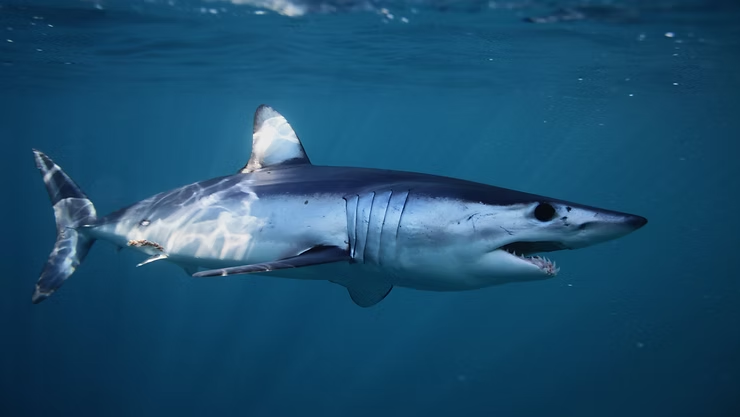The Ocean’s Swift Predators
The Shortfin Mako Shark (Isurus oxyrinchus) is one of the fastest and most formidable predators in the sea. Known for their power, agility, and striking coloration, these sharks command both awe and caution. Despite their strength, their survival is threatened, making conservation efforts more important than ever.
Distinctive Appearance
Shortfin makos stand out with their deep purple to indigo dorsal surfaces, silvery sides, and stark white underbellies. Large gill slits and razor-sharp teeth underline their role as apex predators, while their sleek, muscular build allows bursts of speed unmatched in the ocean.
Behavior and Human Encounters
Mako sharks are bold and aggressive when provoked, sometimes approaching boats or swimming in figure-eight patterns before striking. While they are not habitual man-eaters, their speed and strength can pose risks, particularly to anglers who target them as prized gamefish.
Conservation Status and Threats
The Shortfin Mako is listed as Endangered by the IUCN Red List. Overfishing, high bycatch in tuna and swordfish fisheries, and slow reproductive cycles push them closer to decline. Regulatory loopholes and inconsistent monitoring make conservation even more challenging.
Makos in the Fishing Industry
As highly sought-after gamefish, makos are prized for both their thrilling fight and their meat. Unfortunately, this status has fueled overexploitation. Bycatch further worsens population pressures, leaving many regional populations at dangerously low levels.
Longfin vs. Shortfin Makos
Although closely related, longfin and shortfin makos differ in physical traits:
- Longfin makos have elongated pectoral fins and darker shading around the mouth.
- Shortfin makos feature snow-white mouths and a more robust build.
Unique Adaptations
Shortfin makos are partially warm-blooded, capable of regulating body temperature to enhance speed and hunting efficiency. This endothermic adaptation allows them to thrive in cooler waters, extend migration ranges, and strike with extraordinary power. Their reproductive strategy, ovoviviparity, results in live births, but with long intervals between pregnancies, recovery from population loss is slow.
Conservation Efforts
Global rebuilding plans aim to restore mako populations through strict catch limits, bycatch reduction, and marine protected areas. Public action—such as supporting businesses that reject shark fins and promoting sustainable ecotourism—plays a vital role in protecting these sharks. Still, inconsistent regulations and enforcement remain obstacles.
Pacific Shortfin Makos
In the Pacific, makos are known for even faster growth rates and extraordinary travel distances exceeding 2,000 km in a month. However, management discrepancies across regions hinder effective recovery, leaving conservationists to push for stronger international cooperation and community-driven initiatives.
Conclusion
The Shortfin Mako Shark is a marvel of evolution—an oceanic sprinter built for speed and power. Yet, despite its strength, it is vulnerable to human impact. Safeguarding its future requires collective global action, from stronger regulations to grassroots conservation. Protecting the mako means preserving one of the ocean’s most iconic and awe-inspiring predators.

